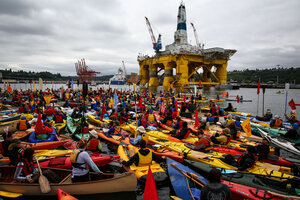Why Shell abandoned Alaskan Arctic drilling, for now
Royal Dutch Shell announced Monday that it is abandoning its drilling venture in Alaska for the 'forseeable future.'

Hundreds of kayaktivists take to the water during a protest against drilling in the Arctic and the Port of Seattle being used as a port for the Shell Oil drilling rig Polar Pioneer, Saturday, May 16, 2015, in Seattle. The protest flotilla drew many paddlers to show their displeasure with the rig being moored in Seattle.
(Daniella Beccaria/seattlepi.com via AP)
Shell announced Monday that it is ceasing offshore oil and natural gas exploration in the Arctic.
The US Geological Survey estimates the Chukchi Sea, where Shell’s test-drilling took place, could contain around 26 billion barrels of recoverable oil. Shell planned to drill up to six wells within the next year, hoping Alaska's Chukchi basin could be “a potential game-changer” in US energy independence.
But after one well, Shell is calling it quits.
“Our decision to stop exploration for the foreseeable future reflects both the Burger J well result, the high cost associated with the project, and the challenging and unpredictable federal regulatory environment in offshore Alaska,” Shell Alaska spokesman Curtis Smith told The Christian Science Monitor.
The Hague-based company originally obtained the necessary licenses to drill in the Chukchi Sea in 2008 when oil prices were more than $100 a barrel. But the price of oil has fallen 50 percent in the past year due to global oversupply. “The entire episode has been a very costly error for the company both financially and reputationally,” analysts at Deutsche Bank, who estimate the failed project could cost the company about $9 billion, told Reuters.
And although Shell insists that they are ending their exploration because of economical and geopolitical reasons, environmentalists are claiming a victory.
“They had a budget of billions, we had a movement of millions. For three years we faced them down, and the people won,” John Sauven, executive director at Greenpeace UK, told Reuters.
Mr. Smith insists that public opinion “did not play a role,” but environmentalists disagree.
Cassady Sharp, Arctic Media Officer at Greenpeace, told The Christian Science Monitor that the recent protests “crystallized more than before” because of “really amazing visual spectacles, voices included.”
This spring and summer “was a great opportunity for the Pacific Northwest to galvanize because they could actually see the rigs off the coast,” adds Ms. Sharp.
Photos of protestors in kayaks over Shell’s drill site spread across social media, encouraging skeptical responses from the company’s own investors, consultants at the International Energy Agency, and presidential candidate Hillary Clinton.
“Investors don’t want Shell to deliver more capex [capital expenditures] into Alaska,” Berstein research analyst Oswald Clint told the Wall Street Journal. “I imagine investors will be OK with a $1 billion hit versus tens of billions in the future.”
There has been doubt expressed from within Shell’s own leadership, as Ben van Beurden Shell’s CEO is reportedly worried that Arctic drilling would damage the company’s stance on climate change. Shell has promoted contradictory environmental claims since the company first publically accepted oil’s role in man-made climate change in 1997.
Because van Beurden has previously promoted natural gas as a “transitional fuel” towards a lower carbon future, Shell’s operations in the Arctic have challenged his reputation.
“The Save the Arctic movement has exacted a huge reputational price from Shell for its Arctic drilling programme. And as the company went another year without striking oil, that price finally became too high. They’re pulling out,” Greenpeace's Saven said in a statement.
But environmentalists insist that now is not a time to be complacent. “We are now asking Obama to take this as an omen and ban offshore drilling,” adds Sharp.

